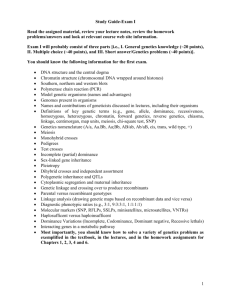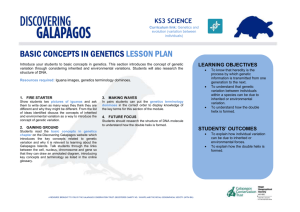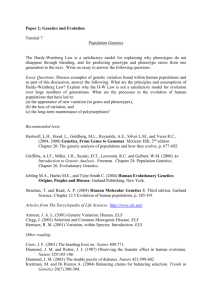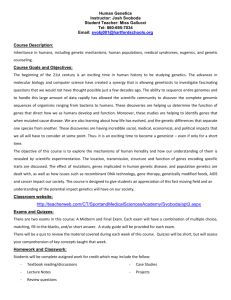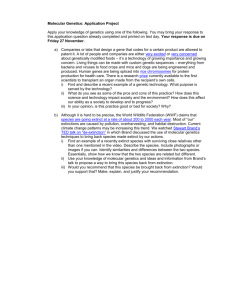Unit 1: Genetics - Scorpion Science with Mrs. Page
advertisement
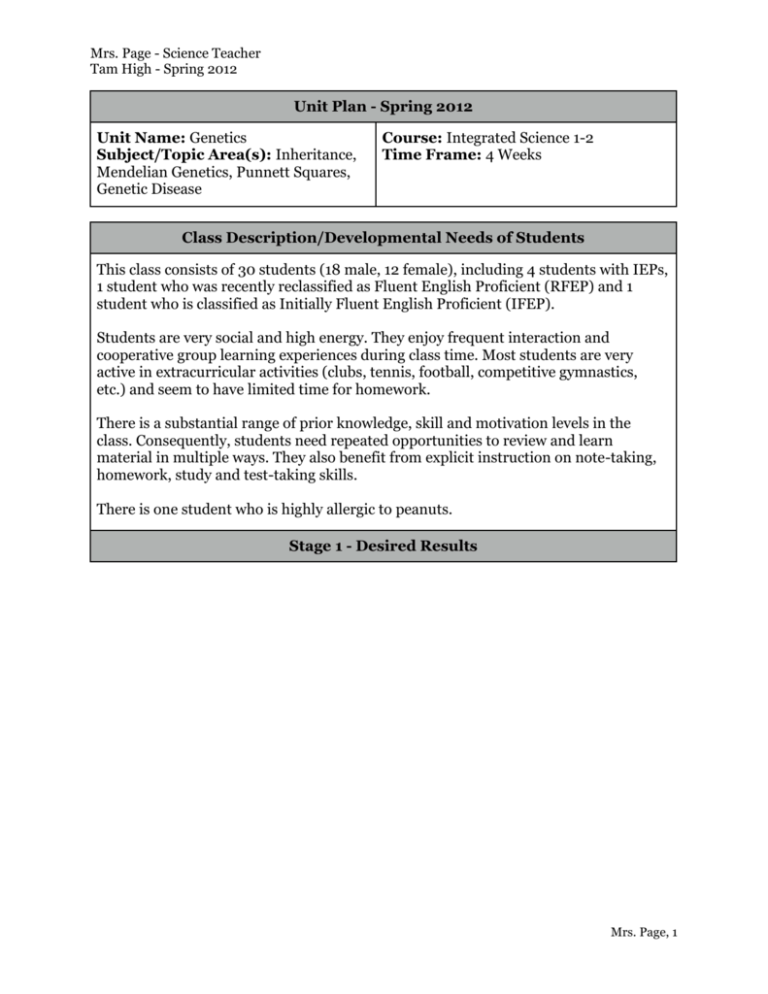
Mrs. Page - Science Teacher Tam High - Spring 2012 Unit Plan - Spring 2012 Unit Name: Genetics Subject/Topic Area(s): Inheritance, Mendelian Genetics, Punnett Squares, Genetic Disease Course: Integrated Science 1-2 Time Frame: 4 Weeks Class Description/Developmental Needs of Students This class consists of 30 students (18 male, 12 female), including 4 students with IEPs, 1 student who was recently reclassified as Fluent English Proficient (RFEP) and 1 student who is classified as Initially Fluent English Proficient (IFEP). Students are very social and high energy. They enjoy frequent interaction and cooperative group learning experiences during class time. Most students are very active in extracurricular activities (clubs, tennis, football, competitive gymnastics, etc.) and seem to have limited time for homework. There is a substantial range of prior knowledge, skill and motivation levels in the class. Consequently, students need repeated opportunities to review and learn material in multiple ways. They also benefit from explicit instruction on note-taking, homework, study and test-taking skills. There is one student who is highly allergic to peanuts. Stage 1 - Desired Results Mrs. Page, 1 Mrs. Page - Science Teacher Tam High - Spring 2012 Class Description/Developmental Needs of Students Established Goals (State and/or National Content Standard (s): Biology/Life Science: 2. Genetics: Mutation and sexual reproduction lead to genetic variation in a population. As a basis for understanding this concept: d. Students know new combinations of alleles may be generated in a zygote through the fusion of male and female gametes (fertilization). e. Students know approximately half of an individuals DNA comes from each parent. f. Students know the role of chromosomes in determining an individuals sex. g. Students know how to predict possible combinations of alleles in a zygote from the genetic makeup of the parents. Biology/Life Science: 3. Genetics: A multicellular organism develops from a single zygote, and its phenotype depends on its genotype, which is established at fertilization. As a basis for understanding this concept: a. Students know how to predict the probable outcome of phenotypes in a genetic cross from the genotypes of the parents and mode of inheritance (autosomal or X-linked, dominant or recessive). b. Students know the genetic basis for Mendel’s laws of segregation and independent assortment. c. Students know how random chromosome segregation explains the probability that a particular allele will be in a gamete. g. Students know how to predict the probable mode of inheritance from a pedigree diagram showing phenotypes. Biology/Life Science: 7. Evolution: The frequency of an allele in a gene pool of a population depends on many factors and may be stable or unstable over time. As a basis for understanding this concept: b. Students know why alleles that are lethal in a homozygous individual may be carried in a heterozygote and thus maintained in a gene pool. Investigation and Experimentation 1. Scientific progress is made by asking meaningful questions and conducting careful investigations. As a basis for understanding this concept and addressing the content in the other four strands, students should develop their own questions and preform their own investigations. Students will: a. Select and use appropriate tools and technology (such as computer-liked probes, spreadsheets and graphic calculators) to perform tests, collect data, analyze relationships, and display data; b. Identify and communicate sources of unavoidable experimental error. d. Formulate explanations by using logic and evidence. e. Recognize the usefulness and limitations of models and theories as scientific representations of reality. Although not explicitly stated in the California State Standards, Tamalpais High School requires that students learn to identify the causes, symptoms and treatments of genetic disorders – both inherited and chromosomal. Mrs. Page, 2 Mrs. Page - Science Teacher Tam High - Spring 2012 Class Description/Developmental Needs of Students Understandings Students will understand that... 1. Mutation and sexual reproduction provide for genetic variation in a population. 2. An individual’s genotype determines its phenotype, which can be predicted using Mendel’s Laws of Segregation and Independent Assortment. 3. Genetic disorders are caused by dysfunctional genes, missing genes and nondisjunction of chromosomes, and can be diagnosed through karyotype analysis and prenatal procedures. Essential Questions: 1. To what extent is DNA destiny? 2. What are the benefits and limits of Mendelian genetics? 3. What is the relationship between probability and genetics? 4. Why do recent developments in genetics involve ethical dilemmas? How would you address these dilemmas? 5. What creates genetic variation and what is the result when something goes wrong during that process? Mrs. Page, 3 Mrs. Page - Science Teacher Tam High - Spring 2012 Class Description/Developmental Needs of Students Knowledge - Students know, explain and apply the following terms: genetics, genes, allele, heterozygous, homozygous, mutation, sexual reproduction, zygote, gamete, haploid, diploid, phenotype, genotype, offspring, generation (P1, F1, etc.), fertilization, DNA, chromosome, dominant, recessive, autosomal, x-linked, Gregor Mendel, Law of Segregation, Law of Independent Assortment, Punnett Square, Monohybrid Cross, pedigree diagram, genetic disorder, nondisjunction, karyotype - Students know that genetic variation in a population is the result of mutation and sexual reproduction. In sexual reproduction, the fusion of male and female gametes at fertilization results in a zygote that contains new combinations of alleles, with approximately half of an individual’s DNA from each parent. - Students know that multicellular organisms develop from a single zygote, and its phenotype depends on its genotype. Students know why chromosomes have a significant role in determining an individual’s sex. - Students understand Mendel’s laws of segregation and independent assortment, and can use monohybrid cross to predict the probable outcome of phenotypes in a genetic cross from the genotypes of the parents and mode of inheritance (autosomal or X-linked, dominant or recessive). - Students know how to predict the probable mode of inheritance from a pedigree diagram showing phenotypes. - Students know how to identify the causes, symptoms and treatments of genetic disorders – both inherited and chromosomal. Necessary Prior Knowledge: From the previous unit on Cells, including cell structure and function, cell cycle, mitosis, meiosis: Students will recall that: 1. Meiosis is an early step in sexual reproduction in which the pairs of chromosomes separate and segregate randomly during cell division to produce gametes containing one chromosome of each type. (CA/Life Science - Genetics 2a) 2. Only certain cells in a multicellular organism undergo meiosis. (CA/ Life Science - Genetics 2b) 3. Random chromosome segregation explains the probability that a particular allele will be in a gamete. (CA/ Life Science - Genetics 2c) Mrs. Page, 4 Mrs. Page - Science Teacher Tam High - Spring 2012 Class Description/Developmental Needs of Students Skills Other Students will be able to: - Apply the scientific method (hypothesis, observation and data collection, analysis and presentation of data, discussion, conclusion) to investigate genetic variation. - Utilize monohybrid crosses to predict the probable outcome of offspring phenotypes from the genotypes of the parents and mode of inheritance (autosomal or X-linked, dominant or recessive). Students will use mathematical calculations, including multiplication, division, probability, rations and percent frequency. - Analyze a pedigree diagram (showing phenotypes) to predict probable modes of inheritance. - Take notes on content, research and present a topic to peers, and create a study guide for the exam. Stage 2 - Assessment Evidence Mrs. Page, 5 Mrs. Page - Science Teacher Tam High - Spring 2012 Class Description/Developmental Needs of Students Performance Tasks Students will demonstrate standard by... 1. Quiz on Genetics (1/22): This quiz will include multiple choice questions on the early ideas about genetics, including Gregor Mendel’s Laws of Segregation and Independent Assortment, and short answer questions on monohybrid Punnett square. The purpose of the quiz is to provide students with opportunities to practice studying and test-taking prior to the unit exam. 2. Unit Exam (1/31): This exam will consist of multiple choice questions on modes of inheritance, Mendelian genetics, monohybrid and dihybrid Punnetttt Squares and genetic disease and short answer questions that address genetic disease and punnetttt squares. Other Evidence (Formative) Homework: 1. Textbook: Read pgs. 759-761, on pg. 761, do qs. 1-4 in complete sentences in your own words! 2. Spongebob genetics worksheets 1&2 3. Genetics Exam Study Guide 4. Brine shrimp analysis/conclusion questions Classwork: 1. Warm-Ups 1-9 2. Making Babies Lab 3. Genetics Worksheet 2. How to Use Punnett SQ PPT & Notes 2. Spongebob Genetics 1 & Spongebob Genetics 2 Worksheets 3. Science courseware.org fruit fly virtual lab 4. Karyotyping Activity 5. Spongebob Practice Quiz 6. Genetic Disorders PPT and Notes 7. Pedigree Problems, Sheets 1-3 8. Brine Shrimp Lab (Effects of Alcohol on Embryos) & Organizer Stage 3 - Learning Plan Days/Steps - See Unit Calendar Special Considerations/Adaptations Mrs. Page, 6 Mrs. Page - Science Teacher Tam High - Spring 2012 Special Considerations/Adaptations ELLs IEPs Health Issues/Allergies Other considerations: Reflection What worked? What didn’t? Important Lessons? Template Adapted by Mrs. Page from Understanding by Design Unit Plan Mrs. Page, 7
